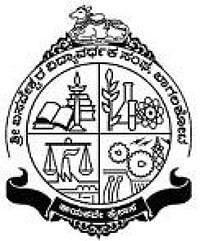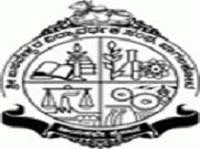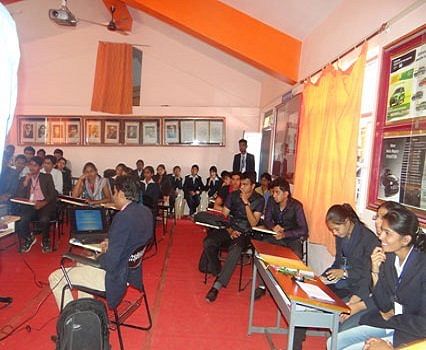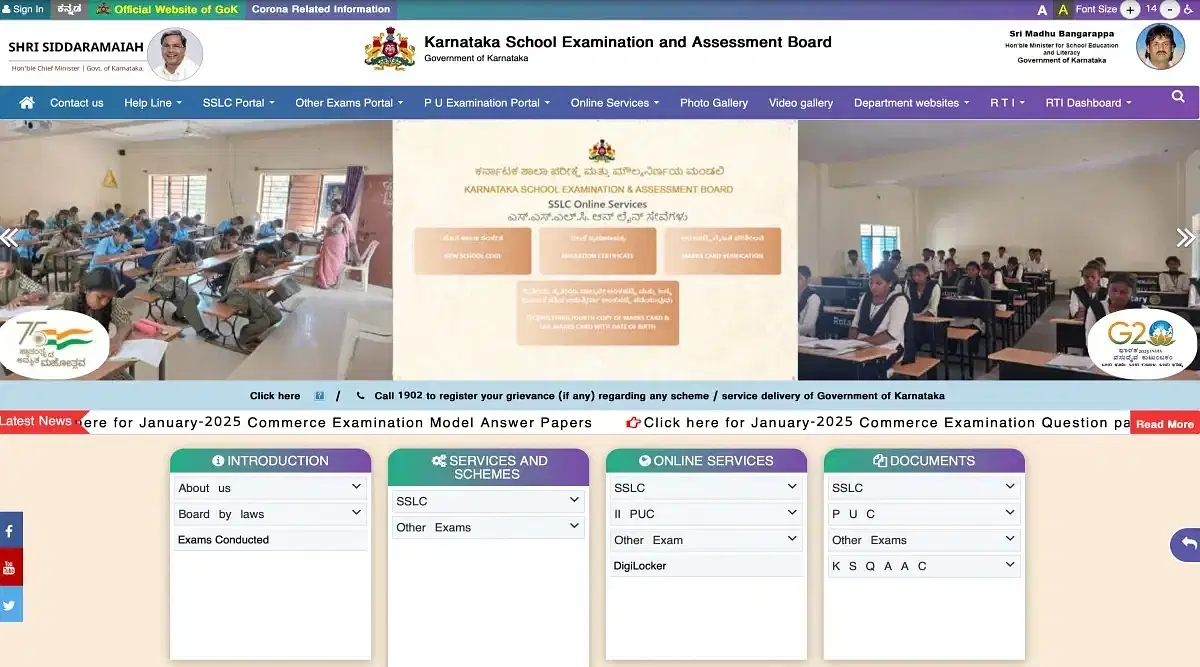Karnataka 2nd PUC Physics Latest Syllabus 2026: Download Latest and Revised Karnataka 2nd PUC Physics Syllabus PDF
Get the latest Karnataka 2nd PUC Physics Syllabus 2026 from DPUE! It's updated, reduced, and crucial for your board exams. The paper is for 100 marks (70 theory, 30 internal). Use this syllabus to score well.
Table of Contents
The Department of Pre-University Education (DPUE) will release the Karnataka 2nd PUC Physics exam syllabus 2025-26. The updated syllabus contains topics such as Atoms, Nuclei, the Dual Nature of Radiation and Matter, Current Electricity, Ray Optics, Wave Optics, and Semiconductor Electronics. It will build up the logical concept and help the candidates understand the marking scheme. Moreover, the board has reduced and updated the latest PUC syllabus for Physics.
The board will conduct the Karnataka 2nd PUC exam 2026 for the Physics paper for 100 marks, of which 70 marks will be allotted for theory and 30 for internal assessment. Students have to use the updated syllabus as it includes the important topics and chapters that must be covered in the board exams.
Karnataka 2nd PUC Physics Syllabus 2025-26: Download
The latest Karnataka 2nd PUC 2025-26 syllabus will be updated on the official website. Students have the option for the 2nd PUC Physics syllabus 2025-26 PDF download to prepare for the upcoming board exams. Furthermore, the direct link to download the PUC 2nd year physics syllabus will be added below.
| Particulars | PDF Link |
| Karnataka 2nd PUC Physics Syllabus 2025-26 | To be updated |
Read more: Karnataka 2nd PUC Exam Pattern 2025
Chapters in 2nd PUC Physics Syllabus 2025-26
The Karnataka Physics 2nd PUC syllabus is similar to the NCERT syllabus of class 12. Students must thoroughly review these chapters to score higher grades in the upcoming board exams. Moreover, the detailed 2nd PUC Physics chapters are given below.
| Chapter No | Chapter Names |
| 1 | Electric Charges and Fields |
| 2 | Electrostatic Potential and Capacitance |
| 3 | Current Electricity |
| 4 | Moving Charges and Magnetism |
| 5 | Magnetism and Matter |
| 6 | Electromagnetic Induction |
| 7 | Alternating Current |
| 8 | Electromagnetic Waves |
| 9 | Ray Optics and Optical Instruments |
| 10 | Wave Optics |
| 11 | Dual Nature of Radiation and Matter |
| 12 | Atoms |
| 13 | Nuclei |
| 14 | Semiconductor Electronics |
Read more: Karnataka 2nd PUC Model Papers 2025
Karnataka 2nd PUC Physics Syllabus 2025-26: Course Structure
The 2nd PUC Physics chapters are divided into two parts. Part I comprises eight chapters, and Part II contains six chapters. Students will be given 3 hours to complete the Physics paper.
- Karnataka 2nd PUC Physics Syllabus 2025-26: Part I
- Karnataka 2nd PUC Physics Syllabus 2025-26: Part II
Karnataka 2nd PUC Physics Syllabus 2025-26: Part I
The 2nd PUC Physics syllabus 2025-26 for Part I is provided below for the students' reference.
| Chapters | Details |
| Electric Charges and Fields | 1.1 Introduction 1.2 Electric Charge 1.3 Conductors and Insulators 1.4 Charging by Induction 1.5 Basic Properties of Electric Charge 1.6 Coulomb’s Law 1.7 Forces between Multiple Charges 1.8 Electric Field 1.9 Electric Field Lines 1.10 Electric Flux 1.11 Electric Dipole 1.12 Dipole in a Uniform External Field 1.13 Continuous Charge Distribution 1.14 Gauss’s Law 1.15 Applications of Gauss’s Law 1.15.1 Field due to infinitely long straight uniformly charged wire. 1.15.2 Field due to uniformly charged infinite plane sheet. |
| Electrostatic Potential and Capacitance | 2.1 Introduction 2.2 Electrostatic Potential 2.3 Potential due to a Point Charge 2.4 Potential due to an Electric Dipole 2.5 Potential due to a System of Charges 2.6 Equipotential Surfaces 2.7 Potential Energy of a System of Charges 2.8 Potential Energy in an External Field 2.9 Electrostatics of Conductors 2.10 Dielectrics and Polarisation 2.11 Capacitors and Capacitance 2.12 The Parallel Plate Capacitor 2.13 Effect of Dielectric on Capacitance 2.14 Combination of Capacitors 2.15 Energy Stored in a Capacitorr |
| Current Electricity | 3.1 Introduction 3.2 Electric Current 3.3 Electric Currents in Conductors 3.4 Ohm’s law3.5 Drift of Electrons and the Origin of Resistivity 3.6 Limitations of Ohm’s Law 3.8 Temperature Dependence of Resistivity 3.9 Electrical Energy, Power 3.11 Cells, emf, Internal Resistance 3.12 Cells in Series and Parallel 3.13 Kirchhoff’s Rules 3.14 Wheatstone Bridge 3.15 Meter Bridge 3.16 Potentiometer |
| Moving Charges and Magnetism | 4.1 Introduction 4.2 Magnetic Force 4.3 Motion in a Magnetic Field 4.4 Motion in Combined Electric and Magnetic Fields 4.4.1 velocity selector 4.5 Magnetic Field due to a Current Element, Biot-Savart Law 4.6 Magnetic Field on the Axis of a Circular Current Loop 4.7 Ampere’s Circuital Law 4.8 The Solenoid and the Toroid 4.9 Force between Two Parallel Currents, the Ampere 4.10 Torque on Current Loop, Magnetic Dipole 4.11 The Moving Coil Galvanometer |
| Magnetism and Matter | 5.1 Introduction 5.2 The Bar Magnet 5.2.1 The magnetic field lines 5.3 Magnetism and Gauss’s Law 5.4 The Earth’s Magnetism 5.5 Magnetisation and magnetic intensity |
| Electronic Induction | 6.1 Introduction 6.2 The Experiments of Faraday and Henry 6.3 Magnetic Flux6.4 Faraday’s Law of Induction 6.5 Lenz’s Law and Conservation of Energy 6.6 Motional Electromotive Force 6.7 Energy Consideration: A Quantitative Study 6.8 Eddy Currents 6.9 Inductance 6.10 AC Generator |
| Alternating Current | 7.1 Introduction 7.2 AC Voltage Applied to a Resistor 7.3 Representation of AC Current and Voltage by Rotating Vectors — Phasors 7.4 AC Voltage Applied to an Inductor 7.5 AC Voltage Applied to a Capacitor 7.6 AC Voltage Applied to a Series LCR Circuit 7.8 LC Oscillations 7.9 Transformers |
| Electromagnetic Waves | 8.1 Introduction 8.3 Electromagnetic Waves 8.4 Electromagnetic Spectrum |
Karnataka 2nd PUC Physics Syllabus 2025-26: Part II
The detailed Part II Physics 2nd PUC chapters are given below for 2025-26.
| Chapters | Details |
| Ray Optics and Optical Instruments | 9.1 Introduction 9.3 Refraction 9.4 Total Internal Reflection 9.5 Refraction at Spherical Surfaces and by Lenses 9.6 Refraction through a Prism 9.7 Some Natural Phenomena due to Sunlight 9.7.1The rainbow 9.8 Optical Instruments (except resolving powermicroscope and astronomical telescope) |
| Wave Optics | 10.1 Introduction 10.2 Huygens Principle 10.3 Refraction and Reflection of Plane Waves using Huygens Principle 10.4 Coherent and Incoherent Addition of Waves |
| Dual Nature of radiation and matter | 11.1 Introduction 11.2 Electron Emission 11.3 Photoelectric Effect 11.4 Experimental Study of Photoelectric Effect 11.5 Photoelectric Effect and Wave Theory of Light 11.6 Einstein’s Photoelectric Equation: Energy Quantum of Radiation 11.7 Particle Nature of Light: The Photon 11.8 Wave Nature of Matter |
| Atoms | 12.1 Introduction Experiment 12.2 Alpha particle Scattering and Rutherford’s Nuclear Model of Atom 12.3 Atomic Spectra 12.4 Bohr Model of the Hydrogen Atom 12.5 The Line Spectra of the Hydrogen Atom 12.6 De Broglie’s Explanation of Bohr’s Second Postulate of Quantisation |
| Nuclei | 13.1 Introduction 13.2 Atomic Masses and Composition of Nucleus 13.3 Size of the Nucleus 13.4 Mass Energy and Nuclear Binding Energy (except binding energy per nucleon and its variation with the mass number) 13.5 Nuclear Force 13.7 Nuclear Energy |
2nd PUC Physics Syllabus 2025-26: Deleted Topics
Students can refer to the table given below to learn about the topics that are removed from the latest Physics syllabus class 12 Karnataka Board
| Chapters | Deleted/ Removed Topics |
| Chapter 1: Electric Charges and Fields | 1.2 Electric Charge, 1.3 Conductors and Insulators |
| Chapter 2: Electrostatic Potential and Capacitance | 2.15 Energy Stored in a Capacitor (delete only derivations) |
| Chapter 3: Current Electricity | 3.7 Resistivity of Various Materials, 3.1 and 3.2 and Carbon resistors, Colour code for 3.10 Combinations of Resistors – Series and Parallel |
| Chapter 4: Moving Charges and Magnetism | 4.4.1 Velocity Selector, 4.4.2 Cyclotron, 4.8.2 The Toroid, 4.10.3 The Magnetic Dipole Moment of a Revolving Electron |
| Chapter 5: Magnetism and Matter | 5.2.2 Bar Magnet as an Equivalent Solenoid, 5.2.3 The Dipole in a Uniform Magnetic Field, 5.41. Magnetic Declination and DipTable 5.25, 6.2 Paramagnetism, 5.6.3 Ferromagnetism temperature; and, 5.7 Permanent Magnets and Electromagnets |
| Chapter 6: Electromagnetic Induction | 6.7 Energy Consideration: A Quantitative Study, 6.8 Eddy Currents |
| Chapter 7: Alternating Current | Figure 7.7 Magnetisation and Demagnetisation of an Inductor, Figure 7.10 Charging and Discharging of a Capacitor, 7.6.2 Analytical Solution, 7.6.3 Resonance, 7.8 LC Oscillations |
| Chapter 8: Electromagnetic Waves | Example 8.1, 8.3.2 Nature of Electromagnetic Waves. Example 8.4 and 8.5 |
| Chapter 9: Ray Optics and Optical Instruments | 9.3 Refraction, 9.7 Some Natural Phenomena due to Sunlight, 9.7.1 The Rainbow, 9.7.2 Scattering of Light. Exercise 9.18 |
| Chapter 10: Wave Optics | 10.3.4 Doppler Effect, Example 10.110.5 Interference of expressions for dark and bright fringes but delete the derivation; delete expression, 10.6 Diffraction, 10.6.3 Resolving Power of Optical Instruments, 10.6.4 Validity of Ray Optics, 10.7.1 Polarisation by Scattering, 10.7.2 Polarisation by Exercises 10.7–10.21 |
| Chapter 11: Dual Nature of Radiation and Matter | Table 11.1Example, 11.311.8 Wave Nature of Matter (delete only derivation for de Broglie wavelength of accelerated electron; and, 11.9 Davisson and Germer Experiment Appendix, 11.1 The History of Wave-Particle Flip-Flop 407–413. Exercises 11.5, 11.7, 11.12 to 11.14, 11.16, 11.17,11.19–11.37 |
| Chapter 12: Atoms | 12.3.1 Spectral Series , 12.4 Bohr Model of the Hydrogen Atom, 12.5 The Line Spectra of the Hydrogen Atom. Exercises 12.3, 12.11–12.17 |
| Chapter 13: Nuclei | 13.6.1 Law of Radioactive Decay, 13.6.2 Alpha Decay, 13.6.3 Beta Decay, 13.6.4 Gamma Decay,13.7.2 Nuclear Reactor. Exercises 13.1, 13.2, 13.6–13.10, 13.12–13.14, 13.18, 13.22–13.31 |
Books for Karnataka 2nd PUC Physics Syllabus 2025-26
Students must use the Karnataka 2nd PUC textbooks for the Physics syllabus to understand the concept thoroughly. The books cover all the chapters and topics from the Karnataka second PUC physics syllabus. The book contains the necessary diagrams and explanations that can enhance the preparation skills of the candidates for the upcoming 2nd PUC Physics exams.
| Particulars | PDF Link |
| Karnataka 2nd PUC Physics Book 2025-26 | Download Now |
FAQs on Karnataka 2nd PUC Physics
Q: Which authority releases the Karnataka 2nd PUC syllabus 2026?
Q: Has the Karnataka II PUC syllabus 2026 been reduced?
Q: How many units are there in the Karnataka 2nd PUC syllabus 2026?
Q: How to download the Karnataka 2nd PUC syllabus 2026?
Q: What is the marking scheme in the Karnataka 2nd PUC exam?
Q: When will the Karnataka 2nd PUC Physics syllabus 2026 be released?
Q: What is the marking scheme for the Karnataka 2nd PUC Physics exam 2026?
Q: Is the Karnataka 2nd PUC Physics syllabus similar to NCERT?
Q: How many chapters are there in the 2nd PUC Physics syllabus?
Q: Where can I download the Karnataka 2nd PUC Physics syllabus PDF?






![Shri Basaveshwara Vidya Vardhak Sangha Ayurvedic Medical College, [SBVVSAMC] Bagalkot](https://media.getmyuni.com/azure/college-image/small/shri-basaveshwara-vidya-vardhak-sangha-ayurvedic-medical-college-sbvvsamc-bagalkot.jpg)

![Shri Vijay Mahantesh Vidya Vardhak Sangha Ayurvedic Medical College, [SVMVVSAMC] Bagalkot](https://media.getmyuni.com/azure/college-image/small/shri-vijay-mahantesh-vidya-vardhak-sangha-ayurvedic-medical-college-svmvvsamc-bagalkot.jpg)























